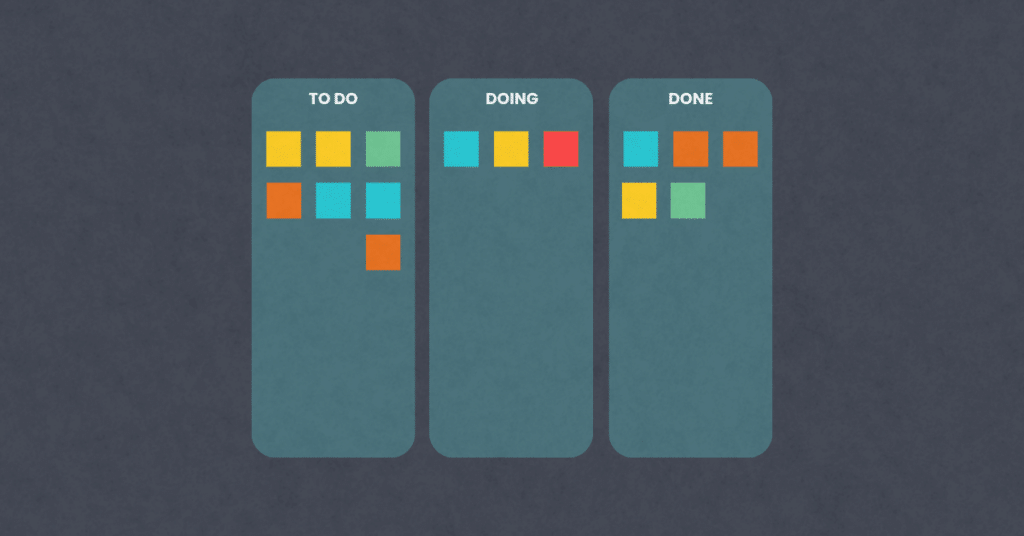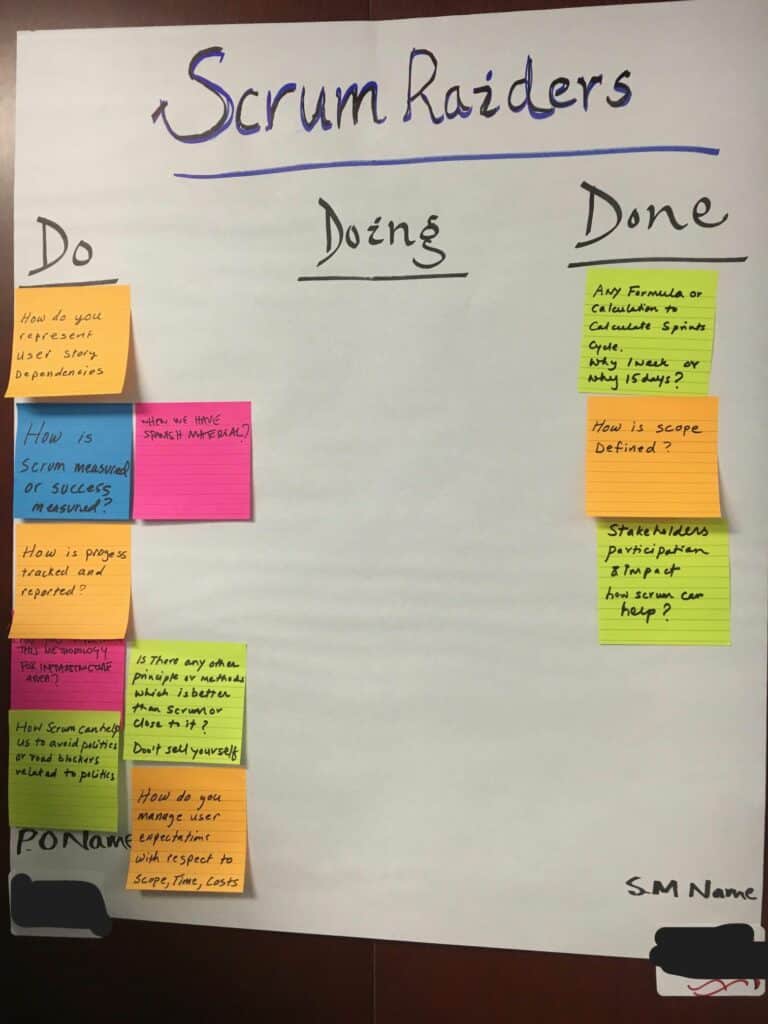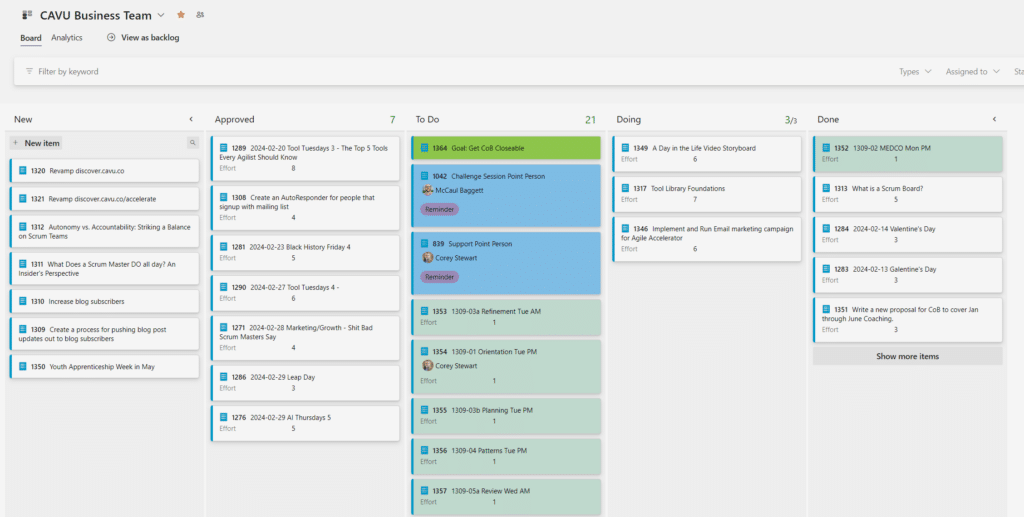Imagine your workday starting not with the usual scramble to remember what needs to be done, but with a clear, visual snapshot of your team’s game plan. On many Scrum teams, the Scrum Board, serves as a simple yet powerful tool that’s transforming how teams tackle projects in the Agile universe.

A Scrum Board is a visual tool tracking work progress during a Sprint, featuring columns like “To Do,” “Doing,” and “Done” for clear, shared work status understanding, aiding focus and track during the Sprint. At its core, a Scrum Board is an organizational hack for your team, turning the abstract (think: ideas, tasks, progress) into something you can see, touch, and move around. It’s not just about making work visible; it’s about making progress feel real.
A well-crafted Scrum Board does more than just show what’s being worked on. It’s a visual story of your team’s Sprint journey, showing where you started, where you’re heading, and the hurdles you’re jumping over along the way. Plus, it’s a champion against the dreaded status meeting. Instead of talking about work, you can actually get to work.
And here’s a little secret: Scrum Boards are part of a larger family—the Team Board. Picture this as your team’s mission control, with the Scrum Board starring front and center, surrounded by insights on past achievements, current challenges, and what the future holds. It’s not just a board; it’s your team’s narrative, constantly evolving.
It’s more than just sticky notes and markers—Scrum Boards can turn chaos into a clear path forward. Because at the end of the day, it’s all about working smarter, not harder.
Understanding the Scrum Board
At its heart, the board is elegantly simple, designed to give everyone a clear picture of the sprint’s narrative through three fundamental components: Columns, Cards, and (sometimes) Swimlanes.
Columns are the backbone of the Scrum Board, typically labeled as To Do, Doing, and Done. Think of these as the chapters of your Sprint’s story, showing the journey of your work from inception to completion. It’s like watching your team’s efforts move physically across the board, turning plans into achievements.
Cards represent the individual Sprint Backlog Items. Each card is a plot-point in your Sprint’s saga, complete with its characters (team members), challenges, and triumphs. These cards move from one column to the next, marking the progress of your work and the unfolding of your team’s efforts.
Swimlanes are optional lanes that can run horizontally across the board, helping to categorize Sprint Backlog Items into different streams of work. Though, a word to the wise for teams new to Scrum Board use: it might be best to keep your board more straightforward without adding too many additional elements. Swimlanes can wait until your team is ready for more complex work management.
The Scrum Board is a living, breathing document of your current Sprint’s progress, evolving with each day. As tasks move from “To Do” to “Done,” the board tells the story of your team’s journey through challenges, learnings, and successes. It’s not just about tracking work; it’s about celebrating progress and learning as a team.
Setting Up Your Scrum Board
Setting up your Scrum Board is the first critical step in visualizing your team’s workflow. It’s about making a choice that best fits your team’s environment and working style. Do you opt for the tactile feel of a physical board, or the versatility of digital tools?

Choosing the Right Medium
Physical Board: The tangible nature of a physical board (like the one above from a training I taught recently), with its sticky notes and markers, brings a certain magic. It’s hands-on, fostering a team’s bond as you gather around to move tasks in real-time. Perfect for co-located teams, it adds a dash of color and reality to your daily stand-ups. However, if your team spans continents, the physical board’s charm might wane, becoming more decorative than functional.
Digital Tools: In contrast, digital boards offer the superpower of accessibility. Whether your team members are in coffee shops or their living rooms, they’re just a click away from the latest update. Tools like Jira, Trello, or iObeya not only track progress but also store a treasure trove of data for analytics. The downside? Sometimes, the simplicity of physical interaction is lost in translation to the digital realm.

Choosing between the two often boils down to your team’s geography and preference. Co-located teams might revel in the physicality of sticky notes, while distributed teams will find digital boards indispensable.
Layout Design
Once you’ve chosen the medium for your Scrum Board, it’s time to plan its structure. The standard layout with columns for To Do, Doing, and Done provides a clear framework for tracking the progress of your tasks.
But your team’s workflow might benefit from a bit of customization. Depending on what your team needs, you could add columns like “Under Review” for tasks awaiting feedback, or “Blocked” to highlight obstacles. The critical thing to remember is that the aim of the Scrum Board is to maintain simplicity and readability. Every addition should make it easier for the team to understand what’s happening at a glance, not add confusion. An overcrowded board can make it hard to see the progress and priorities clearly.
When setting up your Scrum Board, keep it functional and user-friendly. The right setup not only makes it easier for your team to navigate their daily tasks but also helps everyone stay on the same page throughout the Sprint. Simple, clear, and accessible should be your guiding principles.
Features of an Effective Scrum Board
Visual Signals
Using colors, tags, and icons can turn your Scrum Board into an at-a-glance snapshot of project health. For example, different colors can represent various types of tasks (user stories, bugs, technical debt), tags can highlight priorities or categories, and icons can indicate special conditions like blockers. This visual shorthand helps team members quickly assess the board’s state without getting bogged down in details.
Sprint Backlog Item Cards Details
Each card on your Scrum Board is a mini-mission for your team, and how you detail these cards can significantly impact their execution. Effective Sprint Backlog Item Cards should have concise titles that clearly state what needs to be done. While detailed descriptions and acceptance criteria ensure everyone understands the mission’s parameters. In the spirit of Agile, assigning ownership and due dates upfront isn’t necessary. Instead, embrace the flexibility of the “pull” system, where team members take on tasks as they’re ready, keeping the focus on continuous flow rather than arbitrary deadlines.
Progress Tracking
The heart of your Scrum Board’s functionality is progress tracking. As tasks journey from “To Do” to “Doing” to “Done,” the board tells the ongoing story of your Sprint. This movement not only visualizes your team’s progress but also highlights any sticking points in real-time. Centering your Daily Scrum around the board ensures that these updates are part of your team’s daily rhythm, keeping everyone aligned and focused. It turns the board into more than just a tracker; it becomes the stage for your daily strategy discussions and a tool for fostering team communication and collaboration.
Remember, the goal is to keep it simple but significant, ensuring that your Scrum Board is optimized for your team‘s needs. It‘s not just a checklist.
Functions of a Scrum Board
A Scrum Board is more than just a tool for tracking tasks; it’s the heartbeat of your project’s progress.
Facilitating Daily Scrum
Daily Scrums are the pulse checks of your team’s work, ensuring everyone’s pace matches the Sprint’s rhythm. The Scrum Board acts as the focal point for these events. It’s where the story of yesterday’s achievements and today’s goals unfold, providing a visual backdrop to guide the discussion. Team members can discuss their progress in the context of the board, making it easier to understand what’s moving, what’s stuck, and what’s next. This keeps Daily Scrums focused, fast, and productive, turning them into strategic sessions rather than mere status updates.
Promoting Transparency and Accountability
The Scrum Board offers a transparent view of the team’s work to all members and stakeholders. It ensures everyone is on the same page, with a clear understanding of what’s being worked on and the sprint’s overall health. This visibility fosters a culture of accountability, where each team member feels responsible not just for their tasks but for the Sprint’s outcome as a whole.
Identifying Blockers and Dependencies
When a Sprint Backlog Item’s card stagnates in the “Doing” column or is tagged with a blocker icon, it signals the team to rally and strategize a solution. This function of the Scrum Board ensures that issues are addressed promptly, keeping the project’s momentum and minimizing delays.
The Scrum Board, with its simple yet dynamic setup, is essential in steering the team towards Agile practices that enhance transparency, inspection and adaptation.
Best Practices for Maintaining Your Scrum Board
Regular Updates
The pulse of your Scrum Board beats with each update, keeping the project’s status transparent and accurate. Establishing a routine for updates—preferably at the same time every day—offers a consistent snapshot of where things stand. Timing these updates around your Daily Scrum not only prepares the team for a productive meeting but also ensures the board reflects the most current state of play. This habit eliminates confusion and makes the board a reliable source of truth for the team and stakeholders alike.
Engagement from the Whole Team
A Scrum Board is not a solo instrument; it’s a symphony created by the entire team’s participation. Encourage every team member to take active ownership of the board. This means not only moving cards but also contributing to its layout, suggesting improvements, and discussing its effectiveness. Engaged teams are more likely to feel a sense of ownership and commitment to the sprint’s objectives, fostering a collaborative and motivated project environment.
Retrospective Adjustments
At the end of each Sprint, The Retrospective offers a prime opportunity to reflect on the Scrum Board’s effectiveness and adapt as necessary. Feedback on what’s working and what isn’t can lead to adjustments in the board’s layout, the introduction of new columns, or changes in the visual signals used. This practice of continuous improvement ensures that the board remains perfectly attuned to the team’s needs, evolving as a facilitator of Agile practices rather than becoming stagnant.
The Scrum Board is a cornerstone of a Scrum Team’s daily workflow, offering a straightforward yet effective way to visualize work, encourage teamwork, and keep everyone aligned on the Sprint Goal. The Scrum Board is a powerful tool that not only tracks progress but also drives it. Remember, the strength of the Scrum Board lies in its ability to adapt to your team’s needs. So, don’t shy away from making it your own—continuously refine and tweak it to best support your team’s journey towards achieving great results.
We’re eager to hear about your journey with Scrum Boards. Have you found innovative ways to use them, or perhaps faced challenges you’ve overcome? Share your stories and insights in the comments below. Let’s create a community of learning and improvement together. And if you’re looking for more tips and tricks on Agile methodologies, consider following us for more practical advice. Together, we can make Agile work smarter for all of us.








